BeoCenter 2002
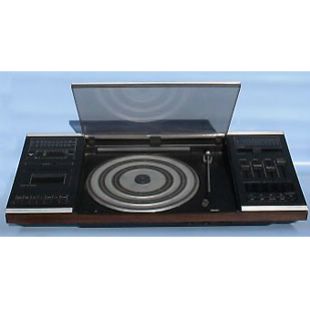

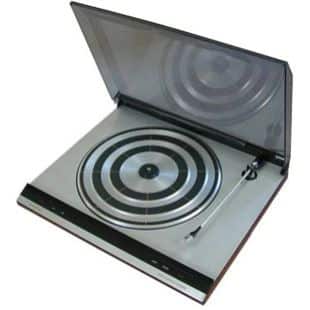
Beogram 6000 – Type 5751 – was a fully automatic record player with one-touch operation.
Put a record on the turntable, touch START and let Bang & Olufsen technology do the rest. The lightweight, low inertia tone arm was fitted with the MMC 20EN pick-up cartridge. This had a naked elliptical diamond and a low Effective Tip Mass which, together with the lightweight arm, secured excellent tracking performance and minimum record wear.
The patented spring suspension system effectively prevented external knocks and vibration from affecting tracking and sound quality. This later radial 6000 model was fitted with Datalink and was really a Beogram 2402 with new electronics in the same design. It really did not match the Beomaster 6000 and was a short lived and frankly unpopular model but was offered as a cheaper alternative to the tangential tracking and tangential drive Beogram 6006. These decks were both replaced by the Beogram 6002. This deck had the newer MMC3 cartridge and was a strange amalgam of the two earlier decks in that it had a simplified tangential arm but belt drive for the platter
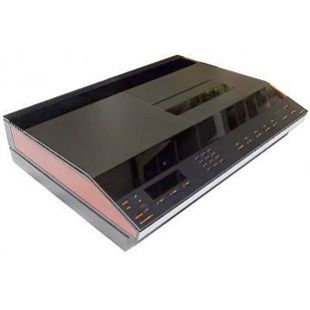
Beosystem 8800 Video was the only fully integrated home video system on the market in the early 1980’s. It comprised the Beocord 8800 video recorder, the Beovision 8800 colour TV, the Beovision Video Terminal and an elegant custom-built stand.
These individual components were designed to match and function harmoniously as one complete system, from a technical, functional, aesthetic and operational point of view. That is why you could operate all primary functions in the entire system from a distance using one infra-red remote control module. This gave you fast, easy, direct access to all facilities, whether these were ordinary TV programmes, recording or playback of video cassettes or Teletext home information services (when the Teletext circuitry is installed). Naturally, you could also make all important sound and video adjustments from the comfort of your chair.
The heart of Beocord 8800 Video was the 2 x 4-hour flip-over cassette – as part of the V2000 video system (similar to VHS and Betamax). It allowed you to make use of up to 8 hours recording time on one cassette, whereas most competing systems offered just 3,25 hours. Thus, the cassette was not only more convenient, it was also more economical to use than any other cassette on the market.
Another outstanding feature was that you could programme the Beocord to make 5 unattended recordings from 5 different TV channels at 5 different times up to 16 days in advance. You could have a relaxing holiday or travel on business, and be rest assured that you wouldn’t have to miss any of the programmes in your favourite TV series.
This creative use of machine intelligence (micro-computers) and the degree of flexibility and convenience afforded were unparalleled in competing video recorders. So too was the ease and speed with which you could operate the machine, thanks to its logical operation facilities and its large communication panel.
The optional stand for the Beosystem 8800 Video was both functional and attractive. It combined the TV receiver and recorder into one harmonious system, making the units even easier to install and convenient to live with at home. The positions of TV and VCR were reversible and the TV shelf had a rotating plate so you could alter its viewing angle at will. Beneath the shelf was a drawer for storing cassettes, headphones and other accessories. The stand was made of black anodised aluminium.
Programming the Beocord 8800 Video to make up to 5 unattended recordings during a 16-day period was both quick and easy, thanks to its logical operation facilities and microcomputers.
Illuminated symbols on the machine’s communication panel guided you through programming, step by step, confirming each step and keeping you informed at all times. You could even check your programming for accuracy and correct mistakes using the clear button. The 8-hour flip-over cassette allowed you to make high quality recordings at a lower cost per programme than ever before. The cassette had a tamper-proof design. Quite simply, it was impossible to damage it by accidentally touching the tape or any of its moving parts. A unique safety slider prevented you from inadvertently erasing a recorded cassette.
The Beovision Video Terminal was a remote control module which transmitted your instructions to the Beovision colour TV or the Beovision 8800 Video on a beam of infra-red light. It gave you immediate access to all primary functions on the Beosystem 8800 Video from anywhere in your room. You could select any of 16 TV channels on the Beovision. Or up to 26 if you made use of the Beocord’s TV tuning and storing facility. You could make video recordings or play a cassette. And if you had Teletext installed in your TV, you could operate this advanced home information service from a distance.
Naturally, you could also adjust volume levels, brilliance and colour without leaving your chair. Or mute the set but retain the picture, if the phone rang.
The Beovision Video Terminal was an integral part of Beovision 8800. Beocord 8800 Video could also be used with non-Bang & Olufsen TVs. If you chose to do so, you could still operate Beocord’s functions from a distance using the Beovision Video Terminal which was available separately (Type 3319).
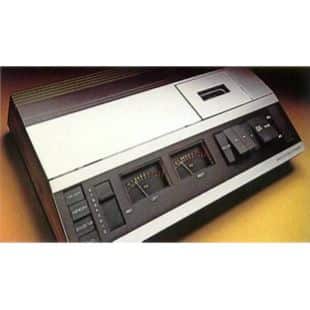
Beocord 1900 equalled Bang & Olufsen’s top-of-the-line cassette deck (Beocord 5000) in terms of specifications and performance, but it but it did not have the same wide range of facilities and operational refinements.
This does not mean that the Beocord 1900 was difficult to operate. On the contrary, the slanting front panel which contained all the operational facilities made the set’s controls handy and easily accessible. The cassette eject mechanism was air damped so that delivery was gentle and controlled. Two large VU meters enabled accurate setting of recording levels.
The microphones socket was placed discreetly under a sliding panel together with a balance control which enabled signal level adjustment in both channels. All the features which characterised high quality and high performance levels in cassette decks were incorporated. These included a combined recording/play-back Sendust tape head and Dolby B Noise Reduction circuits.
Beocord 1900 used precision techniques that ensured stable tape drive and the highest standards of recording and playback. Yet despite its comprehensive facilities it was easy to use and harmonised comfortably with many different Beosystems.
Beocord 1900 could be made up as part of the Beosystem 1900 or Beosystem2400, when linked together with other compatible Bang & Olufsen products.
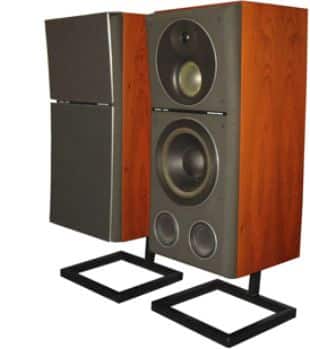
Beovox Uni-Phase MS150 and M150 were Bang & Olufsen’s answer to the need for loudspeakers that could cope with greater dynamic range and increased demand for serious, no-gimmick sound reproduction.
They were B&O’s biggest and most perfected loudspeakers up to the time of their introduction, designed to reproduce sound with a natural, linear phase quality – even at very high sound pressure levels. Their power handling capacities were specified at 150 watts RMS. However, effective overload protection circuits enabled them to handle brief passages of music way above their ratings.
Both speakers reproduced all types of music – from the faintest to the loudest notes – with extreme accuracy and precision, without adding to or subtracting from the signals they received.
In addition, the MS150 was designed to reproduce a clean, powerful bass in a relatively large room. That is why it was fitted with a monitor quality sub-woofer and had a net volume of 64 litres. It reproduced the lowest of tones that any record, tape or FM broadcast could deliver. Apart from the sub-woofer, all other speaker drivers in both models were identical.
Behind this successful design lay a new acoustic technology, an integrated loudspeaker design which put Bang & Olufsen in control of all the parameters that affected the loudspeakers’ performance. That is, all, except the room acoustics in which they were situated.
The new technology was based upon the use of Fourier analysis, computer-aided design and simulation techniques and laser holography. It helped prove measuring, calculating and testing techniques and thereby led to better cross-over filters’ design, refinement of patented linear phase techniques, control cabinet resonances and the minimisation of diffractions caused by the cabinet’s traditionally sharp-edged profiles. There was also a redesigning of the necessary drivers in order to meet precise construction requirements and perform optimally.
A monitor quality sub-woofer, a 20cm bass unit and a 64 litre net cabinet secured clean, powerful, bass reproduction. The mid-range unit, a 7,5cm dome tweeter, was aperiodically tuned to secure the exact frequency response characteristic required, while the super tweeter ensured excellent high frequency response.
Beovox M150-2 featured a 3-unit configuration to ensure monitor-quality sound reproduction in the 38 – 22000 Hz frequency range. Power handling capacity was 150 watts RMS with overload protection on all drive units. The 7,5cm unit acted as a mid-range filler-driver to eliminate audible phase distortion, so the music was always crisp and well defined with individual instruments correctly ‘positioned’ in the musical landscape. Pedestals were included as standard equipment.
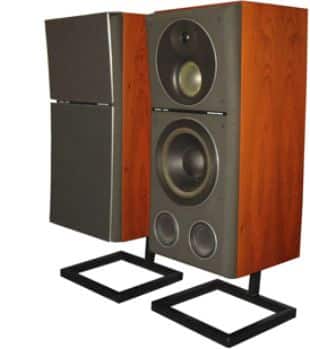
Beovox Uni-Phase MS150 and M150 were Bang & Olufsen’s answer to the need for loudspeakers that could cope with greater dynamic range and increased demand for serious, no-gimmick sound reproduction.
They were B&O’s biggest and most perfected loudspeakers up to the time of their introduction, designed to reproduce sound with a natural, linear phase quality – even at very high sound pressure levels. Their power handling capacities were specified at 150 watts RMS. However, effective overload protection circuits enabled them to handle brief passages of music way above their ratings.
Both speakers reproduced all types of music – from the faintest to the loudest notes – with extreme accuracy and precision, without adding to or subtracting from the signals they received.
In addition, the MS150 was designed to reproduce a clean, powerful bass in a relatively large room. That is why it was fitted with a monitor quality sub-woofer and had a net volume of 64 litres. It reproduced the lowest of tones that any record, tape or FM broadcast could deliver. Apart from the sub-woofer, all other speaker drivers in both models were identical.
Behind this successful design lay a new acoustic technology, an integrated loudspeaker design which put Bang & Olufsen in control of all the parameters that affected the loudspeakers’ performance. That is, all, except the room acoustics in which they were situated.
The new technology was based upon the use of Fourier analysis, computer-aided design and simulation techniques and laser holography. It helped prove measuring, calculating and testing techniques and thereby led to better cross-over filters’ design, refinement of patented linear phase techniques, control cabinet resonances and the minimisation of diffractions caused by the cabinet’s traditionally sharp-edged profiles. There was also a redesigning of the necessary drivers in order to meet precise construction requirements and perform optimally.
A monitor quality sub-woofer, a 20cm bass unit and a 64 litre net cabinet secured clean, powerful, bass reproduction. The mid-range unit, a 7,5cm dome tweeter, was aperiodically tuned to secure the exact frequency response characteristic required, while the super tweeter ensured excellent high frequency response.
Beovox M150-2 featured a 3-unit configuration to ensure monitor-quality sound reproduction in the 38 – 22000 Hz frequency range. Power handling capacity was 150 watts RMS with overload protection on all drive units. The 7,5cm unit acted as a mid-range filler-driver to eliminate audible phase distortion, so the music was always crisp and well defined with individual instruments correctly ‘positioned’ in the musical landscape. Pedestals were included as standard equipment.
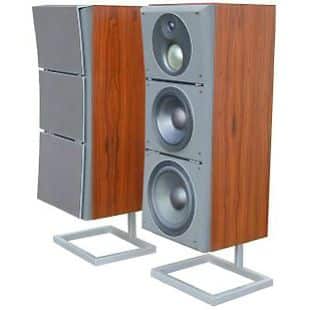
Beovox Uni-Phase MS150 and M150 were Bang & Olufsen’s answer to the need for loudspeakers that could cope with greater dynamic range and increased demand for serious, no-gimmick sound reproduction.
They were B&O’s biggest and most perfected loudspeakers up to the time of their introduction, designed to reproduce sound with a natural, linear phase quality – even at very high sound pressure levels. Their power handling capacities were specified at 150 watts RMS. However, effective overload protection circuits enabled them to handle brief passages of music way above their ratings
Both speakers reproduced all types of music – from the faintest to the loudest notes – with extreme accuracy and precision, without adding to or subtracting from the signals they received.
In addition, the MS150 was designed to reproduce a clean, powerful bass in a relatively large room. That is why it was fitted with a monitor quality sub-woofer and had a net volume of 64 litres. It reproduced the lowest of tones that any record, tape or FM broadcast could deliver. Apart from the sub-woofer, all other speaker drivers in both models were identical.
Beovox Uni-Phase MS150 were well-balanced loudspeakers that would reproduce all types of music – from the faintest to the loudest tones – with accuracy and precision. They were an excellent match for the BeoLab 8000 music system, and other serious high fidelity systems.
Beovox Uni-Phase MS150 loudspeakers had linear phase and linear amplitude transfer characteristics. This meant that they would reproduce sound accurately, without adding to, or subtracting from the signals they received. Power handling capacity was specified at 150 watts RMS but an effective overload protection circuit enabled them to handle much greater loads.
Behind this successful design lay a new acoustic technology, an integrated loudspeaker design which put Bang & Olufsen in control of all the parameters that affected the loudspeakers’ performance. That is, all, except the room acoustics in which they were situated. The new technology was based upon the use of Fourier analysis, computer-aided design and simulation techniques and laser holography. It helped prove measuring, calculating and testing techniques and thereby led to better cross-over filters’ design, refinement of patented linear phase techniques, control cabinet resonances and the minimisation of diffractions caused by the cabinet’s traditionally sharp-edged profiles. There was also a redesigning of the necessary drivers in order to meet precise construction requirements and perform optimally.
A monitor quality sub-woofer, a 20cm bass unit and a 64 litre net cabinet secured clean, powerful, bass reproduction. The mid-range unit, a 7,5cm dome tweeter, was aperiodically tuned to secure the exact frequency response characteristic required, while the super tweeter ensured excellent high frequency response.
Beovox MS150-2 handled a full 150 watts of power easily and accurately. Even musical peaks exceeding this level offered no danger to the drive units as they were protected by an automatic safety cut-out. All frequencies were reproduced faithfully via the 25cm sub-woofer, 20,5cm bass, 7,5cm mid/phase-link and a 2,5cm tweeter unit. Overall, frequency range was 30 – 20000Hz; the extended bass response being a benefit of the ported reflex cabinet design. Sturdy metal pedestals were included to place the speakers at the correct height and vertical angle.

Beovox Uni-Phase MS150 and M150 were Bang & Olufsen’s answer to the need for loudspeakers that could cope with greater dynamic range and increased demand for serious, no-gimmick sound reproduction.
They were B&O’s biggest and most perfected loudspeakers up to the time of their introduction, designed to reproduce sound with a natural, linear phase quality – even at very high sound pressure levels. Their power handling capacities were specified at 150 watts RMS. However, effective overload protection circuits enabled them to handle brief passages of music way above their ratings
Both speakers reproduced all types of music – from the faintest to the loudest notes – with extreme accuracy and precision, without adding to or subtracting from the signals they received.
In addition, the MS150 was designed to reproduce a clean, powerful bass in a relatively large room. That is why it was fitted with a monitor quality sub-woofer and had a net volume of 64 litres. It reproduced the lowest of tones that any record, tape or FM broadcast could deliver. Apart from the sub-woofer, all other speaker drivers in both models were identical.
Beovox Uni-Phase MS150 were well-balanced loudspeakers that would reproduce all types of music – from the faintest to the loudest tones – with accuracy and precision. They were an excellent match for the BeoLab 8000 music system, and other serious high fidelity systems.
Beovox Uni-Phase MS150 loudspeakers had linear phase and linear amplitude transfer characteristics. This meant that they would reproduce sound accurately, without adding to, or subtracting from the signals they received. Power handling capacity was specified at 150 watts RMS but an effective overload protection circuit enabled them to handle much greater loads.
Behind this successful design lay a new acoustic technology, an integrated loudspeaker design which put Bang & Olufsen in control of all the parameters that affected the loudspeakers’ performance. That is, all, except the room acoustics in which they were situated. The new technology was based upon the use of Fourier analysis, computer-aided design and simulation techniques and laser holography. It helped prove measuring, calculating and testing techniques and thereby led to better cross-over filters’ design, refinement of patented linear phase techniques, control cabinet resonances and the minimisation of diffractions caused by the cabinet’s traditionally sharp-edged profiles. There was also a redesigning of the necessary drivers in order to meet precise construction requirements and perform optimally.
A monitor quality sub-woofer, a 20cm bass unit and a 64 litre net cabinet secured clean, powerful, bass reproduction. The mid-range unit, a 7,5cm dome tweeter, was aperiodically tuned to secure the exact frequency response characteristic required, while the super tweeter ensured excellent high frequency response.
Beovox MS150-2 handled a full 150 watts of power easily and accurately. Even musical peaks exceeding this level offered no danger to the drive units as they were protected by an automatic safety cut-out. All frequencies were reproduced faithfully via the 25cm sub-woofer, 20,5cm bass, 7,5cm mid/phase-link and a 2,5cm tweeter unit. Overall, frequency range was 30 – 20000Hz; the extended bass response being a benefit of the ported reflex cabinet design. Sturdy metal pedestals were included to place the speakers at the correct height and vertical angle.
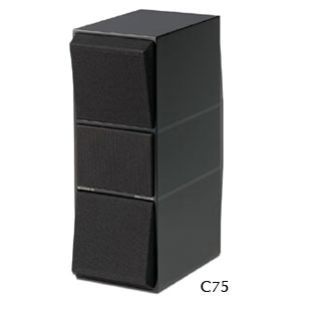
When B&O’s engineers had discovered that the signals from respectively the bass unit and the tweeter in a loudspeaker do not reach the human ear at the same time, and that as a consequence a very slight distortion occurs, they asked Jacob Jensen to design a loudspeaker cabinet in which the units were skewed in relation to each other.
Jensen illustrated B&O’s technical discovery with an angle: “form follows function”. B&O’s loudspeakers in this way achieved a characteristic visual identity in the 1970s and 1980s.” – taken from ‘Jacob Jensen’ by Christain Holmsted Olesen.
Although the speaker was the tallest in the original line-up of aluminium compact passive speakers, Beovox C75 was no taller than an LP record, yet its reproduction quality equalled some of the full-size Beovox models. The one-piece aluminium log-line casing and separate bass (2 x 10cm bass drivers) and treble drivers (1 x 2,5cm) were specially designed to sound best in small rooms. Power handling was 75 watts RMS. Both the C75 and their smaller counterpart, the C40, benefited from the advantages of the “log line transmission system” and exploited the acoustic properties of small rooms to ensure well-balanced sound reproduction quality from these physically small cabinets.
As part of the Beovox Uni-Phase family, they also had linear phase and linear amplitude characteristics, which meant that they reproduced all types of music naturally. The range of C-type speakers won the ID Award in 1978.
Beovox C75 was eventually replaced by the CX100 in 1984.
Beovox C30 and C40 speakers were two compact bookshelf units offering high performance from deceptively small cabinets. The 10cm woofer and 2,5cm tweeter were mounted in thick aluminium casings to eliminate audible resonance. Log-line transmission ensured wide frequency response and clean, clear sound. Ideal for smaller rooms, their power handling capabilities were 30 watts and 40 watts RMS respectively.
The one-piece aluminium log-line casing and separate bass and treble drivers of the Beovox C75 were specially designed to sound best in small rooms. Power handling was 75 watts RMS
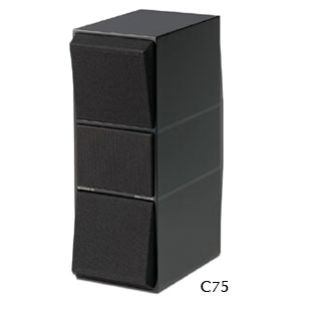
When B&O’s engineers had discovered that the signals from respectively the bass unit and the tweeter in a loudspeaker do not reach the human ear at the same time, and that as a consequence a very slight distortion occurs, they asked Jacob Jensen to design a loudspeaker cabinet in which the units were skewed in relation to each other.
Jensen illustrated B&O’s technical discovery with an angle: “form follows function”. B&O’s loudspeakers in this way achieved a characteristic visual identity in the 1970s and 1980s.” – taken from ‘Jacob Jensen’ by Christain Holmsted Olesen.
Although the speaker was the tallest in the original line-up of aluminium compact passive speakers, Beovox C75 was no taller than an LP record, yet its reproduction quality equalled some of the full-size Beovox models. The one-piece aluminium log-line casing and separate bass (2 x 10cm bass drivers) and treble drivers (1 x 2,5cm) were specially designed to sound best in small rooms. Power handling was 75 watts RMS. Both the C75 and their smaller counterpart, the C40, benefited from the advantages of the “log line transmission system” and exploited the acoustic properties of small rooms to ensure well-balanced sound reproduction quality from these physically small cabinets.
As part of the Beovox Uni-Phase family, they also had linear phase and linear amplitude characteristics, which meant that they reproduced all types of music naturally. The range of C-type speakers won the ID Award in 1978.
Beovox C75 was eventually replaced by the CX100 in 1984.
Beovox C30 and C40 speakers were two compact bookshelf units offering high performance from deceptively small cabinets. The 10cm woofer and 2,5cm tweeter were mounted in thick aluminium casings to eliminate audible resonance. Log-line transmission ensured wide frequency response and clean, clear sound. Ideal for smaller rooms, their power handling capabilities were 30 watts and 40 watts RMS respectively.
The one-piece aluminium log-line casing and separate bass and treble drivers of the Beovox C75 were specially designed to sound best in small rooms. Power handling was 75 watts RMS